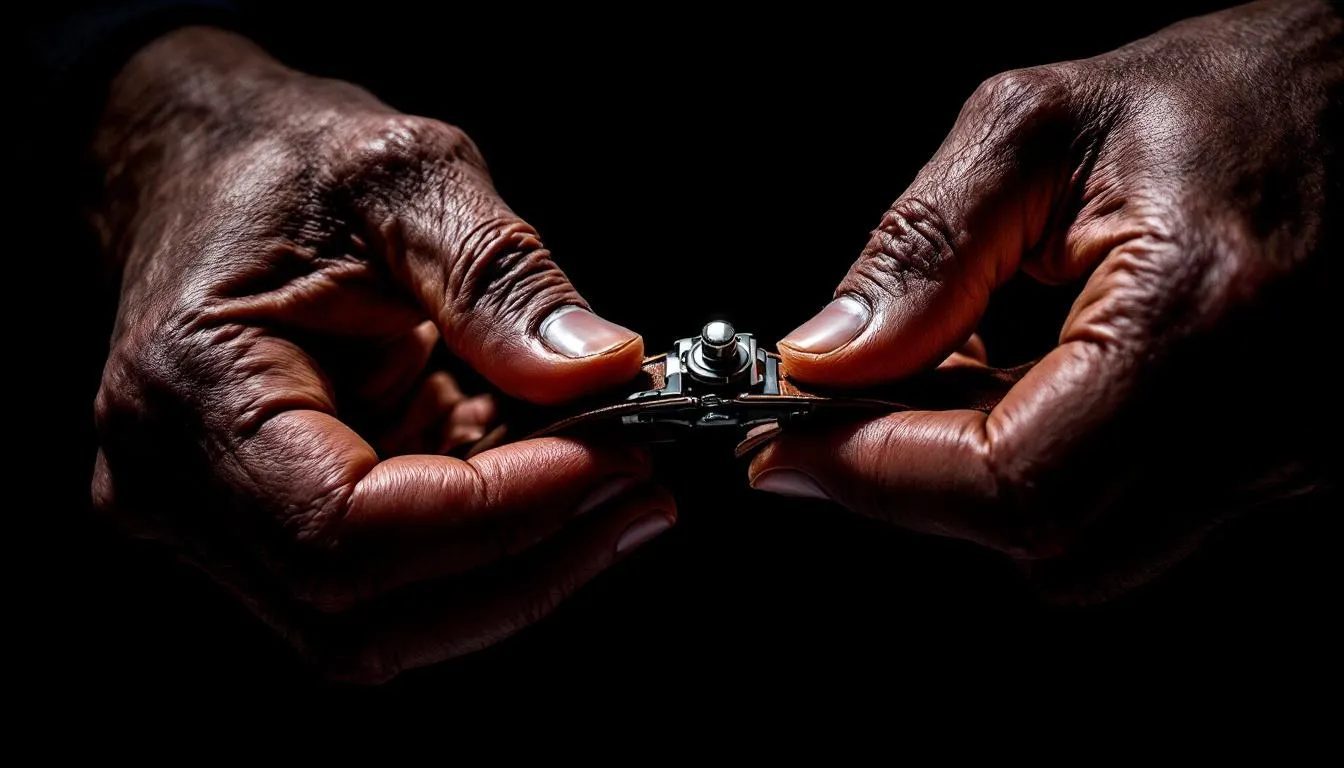Edge play in BDSM involves high-risk activities that push personal and safety boundaries. It’s thrilling but also dangerous, requiring strong trust and communication between partners. Many people are drawn to edge play for its combination of thrill, vulnerability, excitement, and deep emotional connection. This article will explore the types of edge play in BDSM, risks and rewards, and essential safety tips regarding edge play in BDSM risks and rewards and safety tips to ensure a responsible and enjoyable experience.
Key Takeaways
- Edge play in BDSM involves high-risk activities that require trust, communication, and informed consent from all participants.
- Common forms of edge play, including breath play, knife play, fire play, fear play, and blood play, each pose unique risks and safety considerations that necessitate thorough education and preparation.
- Engaging in edge play can foster emotional bonds and personal growth, but participants must prioritize safety, regular check-ins, and aftercare to mitigate physical and emotional risks.
Understanding Edge Play in BDSM

Edge play refers to BDSM activities that push the boundaries of safety and consent, often playing at the edge of comfort zones and limits. These activities are not for everyone, as they require a high level of trust, communication, and understanding between partners. Successful engagement in edge play is contingent upon thorough education and training in the activities. Many people attend workshops led by experienced practitioners to gain hands-on skills and safety knowledge. Educate yourself on human anatomy and the specific techniques involved in chosen edge play activities to ensure safety and informed participation. Edge play requires extensive knowledge of safety protocols, anatomy, and the potential risks involved.
The essence of edge play lies in understanding and respecting limits. Effective communication and explicit consent are paramount. Regular check-ins are essential to ensure the comfort and safety of both partners throughout the BDSM scene. Establish clear verbal and non-verbal safe words or signals that stop the scene immediately. This level of meticulous care is what differentiates edge play from other BDSM activities and makes it a unique, albeit risky, form of kink play.
Edge play fosters a significant level of trust and understanding of power dynamics between participants. This trust can strengthen emotional bonds and create profound connections, as partners rely on each other’s understanding and respect of their limits. Exploring power dynamics in such an intense manner often intensifies the dynamics of trust and control in BDSM relationships. The kink community offers valuable resources, support, and shared best practices for those interested in edge play.
Common Types of Edge Play
Edge play encompasses a variety of activities, each with its unique thrills and hazards. Some common forms include breath play, knife play, fire play, fear play, blood play, high-risk suspension bondage, and electro-stimulation. Medical play is another form of edge play that simulates clinical procedures using tools like needles or scalpels, and it requires careful consent and safety measures due to its higher risks. Electro play is a BDSM activity that involves the use of electrical stimulation for sensory stimulation or psychological arousal. Edging, a BDSM technique involving orgasm control, can also be integrated into edge play for heightened intensity and requires clear communication and consent.
- Breath play
- Knife play
- Fire play
- Fear play
- Blood play
Each form of edge play offers a different experience, pushing boundaries in distinct ways and requiring specific techniques and safety measures.
Breath Play
Breath play involves intentionally limiting oxygen intake during sexual activity, which can create intense sensations and heightened arousal. Breath play is a type of BDSM activity that involves controlling the air supply of a partner to produce sensations of sexual arousal, fear, and excitement. Common techniques include:
- Neck-holding
- Breath-swapping
- Using tools like gags or gas masks Specific forms might involve:
- Choking
- Smothering Breath play activities can range from simple acts like choking to more advanced practices such as smothering and suffocation. These practices can lead to a rush of endorphins and adrenaline, contributing to feelings of euphoria and amplified pleasure.
However, breath play is fraught with risks. Participants may experience sensations like lightheadedness and euphoria, but the activity can also provoke psychological consequences, including intense fear, anxiety, and emotional distress due to its high-risk nature. The dangers are significant, with risks of severe injury or death, particularly when done alone or without proper knowledge and consent.
Consent and education about the anatomy involved in breath play are critical. Understanding the limits of pressure and force is essential to avoid serious harm. It’s important to note that no type of breath play is considered harmless. Due to its serious risks, breath play is infrequently performed in public kink events.
Knife Play
Knife play involves the use of sharp objects to create psychological excitement and trust without intending to inflict harm. Knife play is a BDSM activity that involves the use of knives or other sharp objects as a form of sensory stimulation or as a means of achieving psychological arousal. The primary goal is to evoke emotional responses rather than cause injury, ensuring a consensual and safe experience. The main objective of knife play is to create a sense of vulnerability and trust between the partners. This form of edge play enhances the psychological thrill for participants, fostering trust between partners by creating an intense atmosphere.
Effective communication and established safety measures are crucial in knife play to maintain trust and prevent accidents. Knife play can include activities such as tracing the blade along the skin, making shallow cuts, or using the knife to apply pressure to sensitive areas. The psychological thrill comes from the perceived danger rather than actual harm. This heightened sense of risk makes the experience psychologically intense and emotionally charged, further intensifying the bond between partners.
Knife play requires a steady hand and a clear mind. Practicing safe techniques and ensuring that all parties are comfortable and informed about the limits and intentions of the scene are paramount. This discipline in preparation and execution highlights the importance of trust and communication in edge play scenarios.
Fire Play
Fire play uses flames to create intense physical sensations and emotional experiences, enhancing the erotic aspect of BDSM. The contrast of heat and cool air can produce exhilarating sensory experiences, intensifying arousal. However, fire play demands strict safety measures to prevent harm.
Essential safety equipment and necessary precautions for fire play include:
- Having a fire extinguisher on hand.
- Having a plan to respond to any accidents before engaging in fire play.
- Both participants practicing fire safety techniques and understanding how to use the equipment properly, including first aid and an aid kit.
- Avoiding flammable materials or substances to reduce risks during fire play.
- Implementing safety precautions to ensure a secure environment. Fire play can include activities such as fire cupping, wax play, and fire flogging. Electro play can involve the use of various electrical devices, such as TENS units and violet wands.
- Having a fire extinguisher on hand.
- Having a plan to respond to any accidents before engaging in fire play.
- Both participants practicing fire safety techniques and understanding how to use the equipment properly, including first aid and an aid kit.
- Avoiding flammable materials or substances to reduce risks during fire play.
- Implementing safety precautions to ensure a secure environment.
Engaging in fire play should only occur in controlled environments with proper ventilation and safety measures in place. The sensory thrill and emotional intensity of fire play can create a deeply engaging and memorable experience, but only if conducted with the utmost care and preparation.
Fear Play
Fear play is a form of edge play in BDSM that capitalizes on the psychological intensity induced by fear or anxiety. Methods such as intimidation and role-playing are employed to evoke psychological intensity and engagement. Role play is often used to establish scenarios and boundaries, directly impacting communication and safety protocols during fear play. This form of play can be deeply impactful, relying on the manipulation of fear to create a heightened emotional experience.
Fear play’s effectiveness lies in its ability to tap into deep psychological responses. By pushing these boundaries, participants can explore their fears in a controlled environment, leading to a unique and powerful experience.
Blood Play
Blood play is a form of edge play in BDSM that involves the use of cutting or needle play to incorporate blood for erotic purposes. In blood play, the “top” uses blood to stimulate or intimidate the “bottom” without causing excessive harm. Blood play activities include cutting and needle play. Additionally, blood-letting is also a part of this practice. Needle play involves piercing the skin with needles, typically in a controlled and consensual manner. Blood play is often incorporated into BDSM scenes to heighten the intensity and eroticism of the experience. This form of edge play requires meticulous attention to hygiene and safety to prevent infections and ensure a consensual experience.
The visual and physical presence of blood can create a profound psychological impact. However, the risks associated with blood play necessitate a high level of trust and communication between partners. Proper education and safety measures are essential to practice blood play safely.
Assessing Risks in Edge Play

Edge play includes activities that may breach conventional safety norms, requiring participants to be fully aware of the risks involved. The various forms of edge play include:
- Breath play
- Knife play
- Fire play
- Fear play
- Blood play
- Suspension play Suspension play involves suspending a person from the ceiling or other elevated structure using ropes, chains, or other restraints.
- Breath play
- Knife play
- Fire play
- Fear play
- Blood play Each comes with their own set of risks.
These activities carry significant risk and require careful assessment before participation. Some edge play practices, such as fire play and breath play, can result in serious injury or even death if not performed with proper safety measures. Understanding these obvious risks is crucial for anyone considering engaging in edge play, as it can be extremely risky.
Physical Risks
Edge play involves a multitude of physical dangers that can result in serious injury, nerve damage, burns, bleeding, and infections. Breath play, in particular, carries inherent risks including disorientation, potential brain damage, and in extreme cases, accidental death. Major risks associated with breath play include death, cardiac arrhythmia, and cardiac arrest.
Blood play can involve various methods, including cutting and needle play, which introduce the potential for infection and require careful practice. Without proper education and consent in breath play, there are risks of damage to ligaments, blood clots, bruises, emotional trauma, and assault charges. Ensuring informed and enthusiastic consent from all parties is essential before proceeding with edge play activities.
Clear communication about boundaries and establishing safe word is crucial for safety in edge play, especially when navigating sensitive areas. The physical risks involved in these high-risk activities underscore the importance of proper education and safety measures. It is strongly recommended to always have a first aid kit readily available during edge play scenes to respond quickly to injuries or accidents.
Emotional Risks
Engaging in edge play can result in emotional risks, such as panic attacks, trauma responses, and lasting emotional distress. Common emotional risks include panic attacks, trauma responses, and lasting emotional distress. A common risk with edge play is post-scene emotional drop, wherein both partners might feel depressed or irritable following an intense scene. These risks can strain trust and potentially lead to genuine fear or guilt after a scene.
Understanding and acknowledging these emotional and interpersonal risks is crucial for engaging in edge play safely. Emotional support and open communication are essential components in managing these risks.
Legal Risks
Engaging in edge play can result in legal consequences, particularly if participants do not abide by the principles of informed consent and safety. Informed and enthusiastic consent ensures that all parties are aware of the risks and agree to participate fully and without coercion.
Legal risks can be mitigated by ensuring that all activities are consensual and that all participants are fully informed about the potential risks involved. This adherence to the principles of risk aware consensual kink is essential to avoid legal issues.
Safety Tips for Engaging in Edge Play

Ensuring the safety and well-being of all parties is critical when engaging in edge play. The dominant partner plays a crucial role in ensuring safety, obtaining consent, and managing the scene throughout these activities. People engage in edge play for various reasons, including thrill-seeking, trust-building, and exploring power exchange dynamics. Following essential guidelines and safety measures can help minimize the risks involved in these high-risk activities.
Communication and Consent
Communication is vital in edge play to discuss desires, boundaries, and establish safewords. Participants should discuss boundaries and establish safewords before engaging in activities. Setting nonverbal signals can enhance safety and communication between partners.
Safety in breath play is critical; understanding anatomy and practicing clear communication with partners is essential to avoid serious harm. Breath play activities may lead to legal repercussions, especially if a partner suffers injuries. Informed and enthusiastic consent is the cornerstone of any consensual kink activity.
Proper Techniques and Equipment
Education is vital for learning proper techniques, tools, and safety measures before engaging in edge play. Fire play can create intense sensory experiences but demands strict safety measures to prevent harm. Practicing breath play can lead to serious consequences like cardiac arrest, brain damage, and long-term health complications from lack of oxygen.
Breath play can result in life-threatening situations, including loss of consciousness and irreversible brain damage. Safety scissors and safety shears should always be accessible during breath play to quickly release any restraints if needed. Proper equipment and safety measures are essential to minimize risks.
Regular Check-ins and Aftercare
Aftercare is essential to help participants recover emotionally and physically after engaging in edge play. Regular check-ins during edge play are crucial for ensuring the safety and well-being of all participants. Check-ins provide an opportunity for participants to communicate their comfort levels and any immediate concerns.
Providing thorough aftercare helps in addressing the emotional and physical impacts of the scene, ensuring a positive experience for experienced practitioners. This practice is vital in maintaining the trust and connection between partners.
Rewards of Edge Play

Edge play can lead to intense experiences and adrenaline rushes that heighten the overall thrill when you engage in edge play. Power exchange is a central aspect of edge play, deepening trust and emotional connection between partners.
The potential rewards of edge play will be discussed in the following subsections.
Adrenaline and Sensory Stimulation
The thrill of edge play often leads to heightened adrenaline levels, resulting in intense sensory experiences that produce sensations. Participants can experience heightened sensory awareness, making sensations feel more intense. The euphoric sensations, sexual arousal, and heightened sensory experiences contribute to the appeal of edge play.
Trust and Power Dynamics
Edge play can enhance emotional and psychological bonds between partners due to the vulnerability involved. Engaging in edge play can lead to intense emotional experiences, potentially resulting in long-term psychological issues like anxiety or post-traumatic stress.
Exploring power dynamics in such an intense manner can strengthen the emotional bonds between one partner and partners.
Personal Growth and Exploration
Engaging in edge play can lead to significant personal growth as individuals confront and challenge their limits. Practicing edge play demands individuals to explore their boundaries and understand their emotional and physical limits. This exploration can be a profound journey of self-discovery, helping participants gain insights into their fears and desires.
Through edge play, participants can achieve deeper self-discovery as they negotiate their desires and fears. Overall, edge play serves as a pathway for personal development, allowing individuals to embrace their true selves. This journey of personal growth is one of the most rewarding aspects of engaging in edge play.
Summary
Edge play in BDSM is a thrilling and complex aspect of kink play that involves pushing boundaries and exploring intense sensations and emotions. From breath play and knife play to fire play, fear play, and blood play, each activity offers unique experiences and challenges. Understanding the risks—physical, emotional, and legal—is crucial for anyone considering engaging in edge play. Proper communication, consent, and safety measures are essential to ensure a safe and fulfilling experience.
The rewards of edge play are numerous, including heightened adrenaline and sensory stimulation, enhanced trust and power dynamics, and significant personal growth. By approaching edge play with respect, knowledge, and caution, participants can unlock new levels of intimacy and self-discovery. Embrace the edge, but always prioritize safety and consent.
Frequently Asked Questions
What are the benefits of edge play?
Edge play can intensify orgasms due to the heightened tension and arousal built up through prolonged stimulation. This heightened experience often results in a more profound sense of pleasure and satisfaction.
What is edge play in BDSM?
Edge play in BDSM involves activities that test the limits of safety and consent, incorporating high-risk elements that necessitate comprehensive education, communication, and trust between partners. It is crucial to approach these practices with care and awareness. Consensual non-consent, also referred to as rape play, involves one partner pretending to resist or not consent to a sexual act.
What are some common types of edge play?
Common types of edge play include breath play, knife play, fire play, fear play, and blood play. It is crucial to fully understand the techniques and inherent risks associated with each activity before engaging in them.
What are the risks involved in edge play?
Engaging in edge play entails significant risks, including potential physical injuries, emotional trauma, and legal repercussions if proper consent and safety protocols are not followed. Breath play is the most common cause of death in fatal BDSM incidents. It is crucial to prioritize safety and communication to mitigate these risks effectively.
How can I ensure safety during edge play?
To ensure safety during edge play, prioritize open communication, informed consent, and the use of proper techniques along with safety equipment. Regular check-ins and thorough aftercare are essential for emotional and physical recovery.


























Leave a Response
How can we help?
Still have questions?
Ask your question below and we'll show you the most relevant answers.
Browse by Category
community
Do I need an account to purchase albums?
Yes, speakmydesires needs you to have an account for album purchases, which will have great deals and discounts!